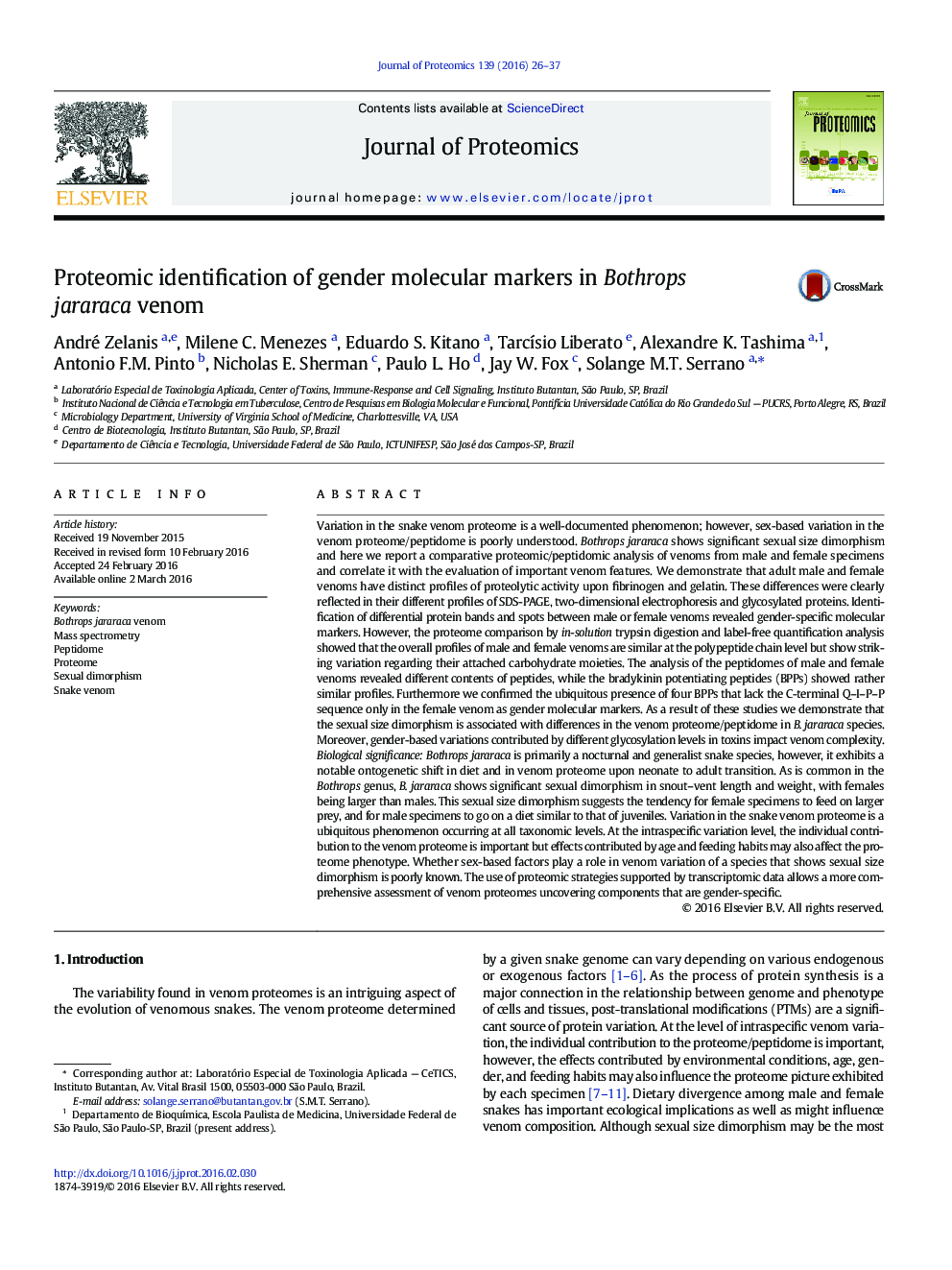| کد مقاله | کد نشریه | سال انتشار | مقاله انگلیسی | نسخه تمام متن |
|---|---|---|---|---|
| 1225210 | 1494742 | 2016 | 12 صفحه PDF | دانلود رایگان |
• The sex-based variability of B. jararaca venom proteome/peptidome was investigated.
• Male and female venoms exhibit distinct 1-DE, 2-DE and glycosylation profiles.
• Male and female venoms show distinct patterns of proteolytic activities.
• Male and female venoms are similar at the protein level, but differ in glycosylation.
• Protein and peptide identification revealed some gender-specific molecular markers.
Variation in the snake venom proteome is a well-documented phenomenon; however, sex-based variation in the venom proteome/peptidome is poorly understood. Bothrops jararaca shows significant sexual size dimorphism and here we report a comparative proteomic/peptidomic analysis of venoms from male and female specimens and correlate it with the evaluation of important venom features. We demonstrate that adult male and female venoms have distinct profiles of proteolytic activity upon fibrinogen and gelatin. These differences were clearly reflected in their different profiles of SDS-PAGE, two-dimensional electrophoresis and glycosylated proteins. Identification of differential protein bands and spots between male or female venoms revealed gender-specific molecular markers. However, the proteome comparison by in-solution trypsin digestion and label-free quantification analysis showed that the overall profiles of male and female venoms are similar at the polypeptide chain level but show striking variation regarding their attached carbohydrate moieties. The analysis of the peptidomes of male and female venoms revealed different contents of peptides, while the bradykinin potentiating peptides (BPPs) showed rather similar profiles. Furthermore we confirmed the ubiquitous presence of four BPPs that lack the C-terminal Q–I–P–P sequence only in the female venom as gender molecular markers. As a result of these studies we demonstrate that the sexual size dimorphism is associated with differences in the venom proteome/peptidome in B. jararaca species. Moreover, gender-based variations contributed by different glycosylation levels in toxins impact venom complexity.Biological significanceBothrops jararaca is primarily a nocturnal and generalist snake species, however, it exhibits a notable ontogenetic shift in diet and in venom proteome upon neonate to adult transition. As is common in the Bothrops genus, B. jararaca shows significant sexual dimorphism in snout–vent length and weight, with females being larger than males. This sexual size dimorphism suggests the tendency for female specimens to feed on larger prey, and for male specimens to go on a diet similar to that of juveniles. Variation in the snake venom proteome is a ubiquitous phenomenon occurring at all taxonomic levels. At the intraspecific variation level, the individual contribution to the venom proteome is important but effects contributed by age and feeding habits may also affect the proteome phenotype. Whether sex-based factors play a role in venom variation of a species that shows sexual size dimorphism is poorly known. The use of proteomic strategies supported by transcriptomic data allows a more comprehensive assessment of venom proteomes uncovering components that are gender-specific.
Figure optionsDownload high-quality image (305 K)Download as PowerPoint slide
Journal: Journal of Proteomics - Volume 139, 29 April 2016, Pages 26–37
